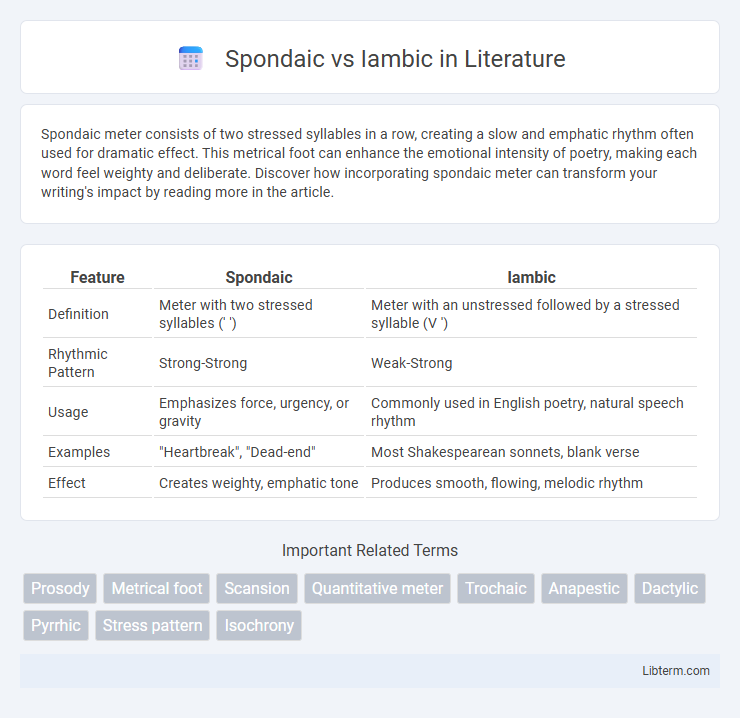Spondaic meter consists of two stressed syllables in a row, creating a slow and emphatic rhythm often used for dramatic effect. This metrical foot can enhance the emotional intensity of poetry, making each word feel weighty and deliberate. Discover how incorporating spondaic meter can transform your writing's impact by reading more in the article.
Table of Comparison
| Feature | Spondaic | Iambic |
|---|---|---|
| Definition | Meter with two stressed syllables (' ') | Meter with an unstressed followed by a stressed syllable (V ') |
| Rhythmic Pattern | Strong-Strong | Weak-Strong |
| Usage | Emphasizes force, urgency, or gravity | Commonly used in English poetry, natural speech rhythm |
| Examples | "Heartbreak", "Dead-end" | Most Shakespearean sonnets, blank verse |
| Effect | Creates weighty, emphatic tone | Produces smooth, flowing, melodic rhythm |
Understanding Spondaic and Iambic Meter
Spondaic meter features two consecutive stressed syllables, creating a heavy, deliberate rhythm often used to emphasize important words or emotions in poetry. Iambic meter consists of alternating unstressed and stressed syllables, producing a natural, flowing rhythm commonly found in English verse such as iambic pentameter. Understanding the contrast between spondaic's forceful beats and iambic's rhythmic rise is essential for analyzing poetic meter and the emotional impact of a poem's cadence.
Definition of Spondaic Meter
Spondaic meter consists of a metrical foot with two stressed syllables, creating a slow and emphatic rhythm often used to emphasize particular words or emotions in poetry. Unlike iambic meter, which alternates unstressed and stressed syllables to produce a natural rising rhythm, spondaic feet produce a heavy, deliberate beat that can intensify the mood or tone. This metric pattern frequently appears in classical Greek and Latin poetry as well as in English verse to mark dramatic moments or highlight key themes.
Definition of Iambic Meter
Iambic meter is a rhythmic pattern in poetry consisting of alternating unstressed and stressed syllables, often represented as da-DUM. This metrical foot creates a natural, flowing cadence commonly found in English verse, such as in Shakespeare's sonnets. Contrastingly, spondaic meter features two consecutive stressed syllables, producing a heavier and more forceful rhythm.
Key Differences Between Spondaic and Iambic
Spondaic meter consists of two stressed syllables in succession, creating a forceful and deliberate rhythm, while iambic meter features an unstressed syllable followed by a stressed syllable, producing a natural and flowing cadence. The key difference lies in stress patterns: spondees emphasize equal stress on both syllables, often used to highlight important words, whereas iambs create a rising rhythm commonly found in English poetry and verse. Understanding these differences is crucial for analyzing poetic meter, as spondas add emphasis and weight, contrasting with the lighter, more rhythmic quality of iambs.
Historical Context of Spondaic and Iambic Verse
Spondaic and iambic meters have roots in ancient Greek and Latin poetry, where spondaic verse was often used to convey solemnity and emphasis through its equally stressed syllables, as seen in epic and hymnal texts. Iambic meter, characterized by alternating unstressed and stressed syllables, gained prominence in classical Greek drama and later shaped English poetic traditions, especially in sonnets and blank verse during the Renaissance. The historical development of these meters reflects their distinct rhythmic functions: spondaic for weighty, deliberate expression and iambic for natural speech patterns that enhance narrative flow.
Examples of Spondaic Meter in Poetry
Spondaic meter in poetry is characterized by two stressed syllables in succession, such as in the phrase "heartbreak" or "sunset." Classic examples include the word pairs "dead set," "long night," and phrases like "break, break" from Alfred Lord Tennyson's works. Spondaic feet often create a slow, heavy rhythm that emphasizes tension or solemnity, contrasting with the lighter, alternating unstressed-stressed pattern of iambic meter found in Shakespearean sonnets.
Examples of Iambic Meter in Poetry
Iambic meter features a rhythmic pattern of an unstressed syllable followed by a stressed syllable, exemplified in classical poetry such as Shakespeare's sonnets and Milton's "Paradise Lost." Examples include the line "Shall I compare thee to a summer's day?" from Shakespeare's Sonnet 18, where each foot follows the da-DUM pattern characteristic of iambic pentameter. This meter creates a natural flow and cadence that mimics everyday speech, making it a dominant choice in English poetic tradition.
Effects of Spondaic vs Iambic on Poetic Rhythm
Spondaic meter, characterized by two equally stressed syllables, creates a slow, heavy rhythm that emphasizes solemnity and gravity in poetry. Iambic meter, consisting of an unstressed syllable followed by a stressed syllable, generates a natural, flowing cadence that mirrors everyday speech, enhancing readability and emotional resonance. The contrast between spondaic and iambic rhythms affects the poem's mood and pacing, with spondees often breaking the smoothness of iambic lines to highlight tension or importance.
Choosing Between Spondaic and Iambic for Creative Writing
Choosing between spondaic and iambic meter in creative writing depends on the desired rhythm and emotional impact. Spondaic meter, characterized by two stressed syllables per foot, conveys emphasis and urgency, making it ideal for intense or dramatic scenes. Iambic meter, with its alternating unstressed-stressed syllables, creates a natural, flowing cadence suited for storytelling and reflective moments.
Spondaic and Iambic in Modern Literature
Spondaic and iambic meters play crucial roles in shaping modern literature's rhythm and tone, with iambic meter often dominating due to its natural, flowing pattern that mirrors everyday speech. Spondaic meter, characterized by two stressed syllables in succession, is employed strategically to create emphasis, tension, or a heavier, more deliberate pace within modern poetic and prose works. Contemporary authors and poets use the interplay between spondaic and iambic patterns to enhance emotional impact and drive narrative pacing, demonstrating the enduring influence of these metrical forms in literary expression.
Spondaic Infographic

 libterm.com
libterm.com